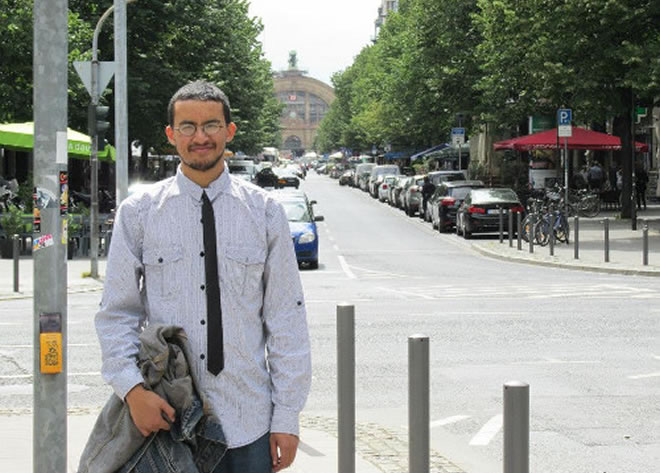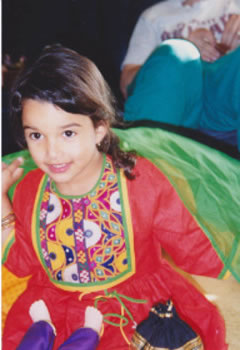
Yusuf Mohammad, one of the administrators of the Facebook group, “Are You Half Somali?”— in California on Sept. 2, 2014. (Photo by Hassan M. Abukar/ For Sahan Journal).

by Hassan M. Abukar
Tuesday, December 23, 2014
When Zulaikha, a light-skinned red head, was in kindergarten, she had an epiphany. She found out that her Somali mother was unique. At the time, Zulaikha was a student in a predominantly white school in California. When the young children saw a black woman picking her up after classes and sometimes volunteering at their school, they were perplexed.
“Zulaikha, are you adopted?” the children would ask. When Zulaikha told them no, they would say, “Then how come your mother is black?”
Zulaikha and her siblings, Amina Caddey, 25, and Yusuf Mohammad, 26, are the offspring of a white father and a Somali mother. They are also active members of the Facebook group, “Are You Half Somali?”— a private group that is strict about who joins.
The objective of the group is clear. “It is for mixed Somalis to exchange their views, thoughts, experiences, and, most of all, positively the blessing of belonging to more than one culture.” Even though the group is private, “Non-half Somalis are welcome, but haters are not.”
The group occasionally receives nasty messages, ostensibly from some Somalis who question its intention and its very existence. These naysayers are mostly individuals who believe there is no such thing as a half-Somali. “Anyone whose father is not Somali is not Somali, these critics believe,” explains Yusuf Mohammad, one of the administrators of the Facebook group, which includes half-Somalis of German, Native American, French, Japanese, Chinese, Arab, Finnish, and Indian ancestries. Indeed, the group is a mini-United Nations group that has one common denominator— a Somali half.
Interestingly, the majority of the half-Somali group members have Somali mothers, Yusuf says.
Amina Caddey likes associating with members of this diverse group. “I like to network with people who have a similar background and share with them our uniqueness,” she says.
One day, Amina went to a student conference with her cousin, a full-blooded Somali. The cousin introduced her to another young Somali woman who was immediately shocked by Amina’s light skin. After a minute of staring at Amina closely, the young lady finally issued a verdict: “I can see the traces of Somaliness in you,” she told Amina. “But you are so white.”

Amina Caddey at age 5 around 1994. (Photo by Hassan M. Abukar / For Sahan Journal).
|
Amina laughed and told her that she hears that from other Somalis all the time. Once, an elderly Somali woman asked Amina’s cousins why they were hanging out with two white kids. When the elderly woman was told that Amina and her sister Zulaikha, in fact, related to the children, the Somali woman was astounded. Then, suddenly, the woman started inquiring about the clan of their white father.
“It was a bizarre encounter,” Amina said, smiling. “Many people simply want to put me in a box.”
Yusuf recalled attending a weekend Islamic school. The first day, the Egyptian teacher asked students who spoke Arabic to raise their hands. Several students did. Then the teacher turned to Yusuf and admonished him for not raising his hand. “I do not speak Arabic,” Yusuf told the teacher. Baffled, the teacher became speechless. “I guess, she automatically assumed I was an Arab,” he says.
The half-Somali group was founded in 2008; however, it experienced an unprecedented peak in 2011 when many “halfies”—as they call themselves—joined.
The half-Somali group has interesting tales to tell — some extremely rare, others simply outrageous.
There is one rare case of a young lady who is half-Somali and half-Japanese. The Japanese, coming from a nation that is homogenous like Somalia, rarely marry outside their group. However, love, as it is popularly said, is blind. A Japanese journalist covering a story in Kenya met a Somali woman, and the two fell in love. Today, the couple’s daughter, who grew up in Japan, is also part of the half-Somali group.
Then there is the weird case of a person who tried to join the group because she was half-Somali and half-Somalilander. “It was a ludicrous attempt,” says Amina Caddey, “to instill politics in an otherwise cultural and multi-ethnic group.” Incidentally, the residents of Somalia and Somaliland — a self-declared independent entity — are both ethnic Somalis.
A half-Somali group might appear strange to many Somalis, but its members bring a greater richness of culture and a whole new perspective to the Somali community at large. The cultural horizons have indeed expanded worldwide. It was, after all, a child with a strange name, a Kenyan father and a white mother from Kansas who became the forty-fourth president of the United States of America.
Hassan M. Abukar is a freelance writer and Sahan Journal contributor. He can be reached at abukar60@yahoo.com.